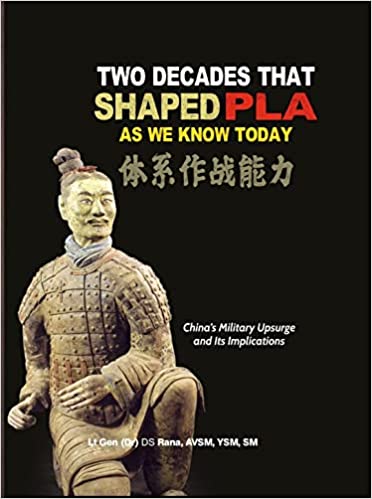For Whom the Bell Tolls: A Note on John J. Mearsheimer’s Article on the Collapse of the Liberal International Order
Edward Hopper, Cape Cod Morning, 1950
In
Login if you are already registered
(votes: 10, rating: 4.8) |
(10 votes) |
Doctor of History, Professor, Ural Federal University, RIAC Expert
In the second decade of the 21st century, the mood of publications by Western (primarily American) political scientists has slipped into pessimistic assessments of the crisis of the liberal world order. One of the champions of the liberal order, Joseph Nye, doubts that the “liberal order” will survive the current crisis.In a recently published article entitled “Bound to Fail. The Rise and Fall of the Liberal International Order,” American political scientist and neo-realist John J. Mearsheimer aims to determine the causes of the decline of the contemporary world order and define the type of order that could replace the current “liberal” version. Mearsheimer urges, above all the ruling elites, to recognize that that the liberal international order was a failed enterprise with no future and says they should resist any temptation to continue trying to forcefully spread democracy across the planet via regime change. Mearsheimer concludes that the “overarching international order” that is taking shape will be based on realist principles of managing the global economy and dealing with issues of arms control and global problems such as climate change rather than focusing on an ideal of creating like-minded democratic states.
In 1984, Robert Keohane acknowledged the possibility of one of the world’s superpowers achieving global hegemony [1], and the concept of establishing a unipolar liberal world order led by the United States has dominated scientific and political circles since the collapse of the USSR.
However, in the second decade of the 21st century, the mood of publications by Western (primarily American) political scientists has slipped into pessimistic assessments of the crisis of the liberal world order. One of the champions of the liberal order, Joseph Nye, doubts that the “liberal order” will survive the current crisis. In his opinion, the crisis was caused by the fact that the liberal order “was largely limited to a group of like-minded states centered on the Atlantic littoral,” and that “it did not include many large countries such as China, India, and the Soviet bloc states” [2]. It’s clear that the topic of the crisis of the “liberal” international order has firmly entered the scientific discourse of Russian and foreign analysts.
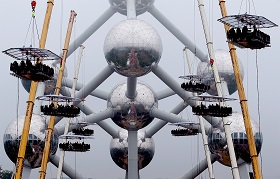
The Inevitable, Weird World
On October 11, 2017, The New York Times drew attention to the so-called “Trans-Atlantic manifesto” prepared by a team of German foreign policy experts stating that the actions of President Donald Trump have put the “liberal world order” in danger. According to the experts, Trump’s victory dealt a heavy blow to the normative foundations of Western liberalism. The “manifesto” notes the importance of liberal values and institutes for Germany’s prosperity and insists on aligning the country’s participation in transatlantic relations against the European context.
In his critical analysis of the “German manifesto,” Josh Busby calls for looking the truth in the eye. The crisis of the “liberal world order” began before Donald Trump came into power, which means that Trump is a product of it himself. “The liberal order is imploding,” he writes, “and the liberal community idea has proven to have been a myth.” Busby continues to note that fundamental changes are taking place in today’s world — changes that are characterized by the growth of non-state actors, the fragmentation of global governance, the emergence of new ideas and norms (many of which are not liberal) and the expansion of global and functional interdependence. A return to the old liberal order is impossible, and, as the analysis concludes, we need to accept this fact. Europe and the United States need to adapt to the new realities of global politics, which will combine liberal functions with other features. The future of the world lies in the development of a more universal community and an order that is more consistent with the diversity and pluralism in its norms, means of communication and leadership. The narrow focus on the liberal order led to the neglect of many other voices in global politics.
The article of the American neo-realist John J. Mearsheimer, who expressed his views on the transformation of the contemporary world order in his typically harsh and pragmatic manner, fit perfectly in the heated discussion on the crisis of the world order today.
In a recently published article entitled “Bound to Fail. The Rise and Fall of the Liberal International Order,” Mearsheimer aims to determine the causes of the decline of the contemporary world order and define the type of order that could replace the current “liberal” version [3].
Let us start with determining what the author means when he says “world order.” Mearsheimer believes that the “global distribution of power” is the dominant factor in defining the world order. This much is clear from his assessment of the evolution of the world order following World War II.
The American political scientist identifies three main differences between “orders.” The first difference he establishes is between “international orders” and “bounded orders.” For an order to be international, it must include all of the world’s great powers.
“Bounded orders” are intended primarily to enable great powers to compete with each other. Mearsheimer identifies the following “international orders” that great powers can organize: realist, agnostic and ideological (including liberal). The choice of order depends primarily on the distribution of power among the great powers. The key issue is whether the system is bipolar, multipolar or unipolar.
After World War II, the system transitioned from a multipolar to a bipolar world order (1945–1989). As the main protagonists of the post-War world, the United States and the Soviet Union formed an “overarching international order” that was neither liberal nor communist in nature, but one that “was fully consistent with the security interests of both sides.”
After the collapse of the Soviet Union, the U.S. administration, starting with that of George H. W. Bush, set about organizing the liberal international order and spreading it across the globe. The United States used existing international institutes (the United Nations, the arms control regimes, etc.) to achieve this end.
The creation of the liberal world order involved dealing with three main tasks. First, it was necessary to expand the presence of the adherents of the liberal order within those international institutions. Second, an open and inclusive international economy that would ensure maximum free trade and help free up capital markets had to be created. It was assumed that this hyper-globalized global economy would become more ambitious in scale than the economic order of the Cold War period. Third, it was important to actively export liberal democracy throughout the whole world.
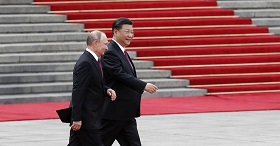
Russia, China and the New World Order
The execution of these three tasks fit in with the main liberal theories, such as liberal institutionalism, economic interdependence and the theory of a democratic world. Thus, in the minds of its architects, the construction of a strong, sustainable and liberal world order was synonymous with the creation of a peace-loving world.
The integration of China and Russia into the liberal order was particularly important for the order itself to succeed, as they were the most powerful countries in the world behind the United States. The goal was to incorporate them into as many institutions as possible and fully integrate them into an open international economy, which would thus help transform them into liberal democracies.
The expansion of NATO into Eastern Europe was an indication of the desire of the United States and its allies to create a liberal international order. NATO’s movement towards the east was not a part of the classic strategy of containing Russia. The goal was different — to integrate the countries of Eastern Europe, and perhaps Russia, into the liberal “security community” that had formed in Western Europe during the Cold War.
The United States based its policy towards China on the same liberal logic. Former Secretary of State Madeleine Albright claimed that engagement would lead to China’s active membership in major global institutions and help integrate it into the U.S.-led economic order. In this case, China would become a “responsible stakeholder” in the international system, highly motivated to maintain peaceful relations with other countries. Engagement would help turn China into a liberal democracy.
Mearsheimer believes that the Bush Doctrine, which was developed over the course of 2002 and used to justify the March 2003 invasion of Iraq, is an example of the global U.S. policy aimed at building a liberal international order. According to the U.S. administration, the best way to combat nuclear proliferation and terrorism was to turn all the countries of the Greater Middle East into liberal democracies that would transform the region into a giant zone of peace, thereby eliminating the twin problems of nuclear proliferation and terrorism. Mearsheimer goes on to quote George W. Bush directly: “The world has a clear interest in the spread of democratic values […] because stable and free nations do not breed the ideologies of murder. They encourage the peaceful pursuit of a better life” [1=4].
In the early 1990s, many observers believed that the United States was in a good position to build a liberal international order. There was a widespread belief in the West that political changes had reached a point where there was no viable alternative to liberal democracy. China was in the early stages of its rise, and Russia was in a state of weakness throughout the 1990s. At the time, it was widely believed in the West that eventually almost every country in the world would become a liberal democracy. This point of view was put forward very convincingly by Francis Fukuyama in his book The End of History. During the 1990s and the early 2000s, the United States and its close allies were moving ever closer to the creation of a full-scale liberal international order.
Mearsheimer calls the period from 1990 to 2004 the “Golden Years” for the successful implementation of the liberal project. According to Freedom House, 34 per cent of the countries in the world were democracies in 1986, growing to 41 per cent by 1996 and 47 per cent by 2006. Few people expected that it would begin to crumble a few years into the 2000s.
Mearsheimer makes an important clarification to explain the attitude of realist thinkers to the concept of the “liberal” world order. “One might think that NATO expansion, U.S. efforts to turn China into a liberal democracy, and the Bush Doctrine are all evidence of untethered realism that unipolarity made possible. This conclusion would be wrong, however. It is clear from the discourse in policymaking circles and within the foreign policy establishment that these policies were motivated by liberal theories and that the United States and its allies in the West were firmly committed to building a liberal international order that would transcend balance of power politics. Almost all realists, it is worth noting, opposed NATO expansion, the Iraq War, and the Bush Doctrine. Moreover, they favored emphasizing containment over engagement in dealing with China. If the United States had been guided by realist logic in the aftermath of the Cold War, it would have sought to create an agnostic international order and pursued the policies advocated by realist thinkers” [5].
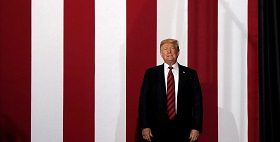
Why Should We Be Grateful to Donald Trump?
From 2005 onwards, the liberal order started to encounter such serious problems that it began to collapse. Mearsheimer lists the blunders of the United States and its NATO allies in Iraq, Afghanistan, Syria, Libya and Yemen among the failures of the plan to create a “liberal world order.” The United States and its allies “inadvertently played a central role in spreading illiberal disorder” in these regions. The rejection of the proposed Treaty for Establishing a Constitution for Europe in 2005 was followed by a crisis in the Eurozone, a souring of relations between Germany and Greece, Brexit, the spread of right-wing extremist xenophobia, and the emergence of illiberal positions among the leaders of several Eastern European states.
Mearsheimer predicts that relations between Russia and the West will worsen still. The reason for this, he believes, is the expansion of the European Union and NATO towards the East, the Ukrainian crisis, and the West’s efforts to promote democracy in countries such as Georgia and Ukraine, and even Russia itself. Given this state of affairs, Moscow is looking for opportunities to sow discord in the West and weaken the European Union and NATO.
Mearsheimer believes that the cracks in the transatlantic relationship have deepened as a result of the election of Donald Trump as President of the United States. Trump is suspicious of almost all the institutions that make up the liberal international order, including the European Union and NATO, which he sees as being obsolete. On this platform, there is a deep distrust between Trump and European leaders.
Mearsheimer then talks about the global financial crisis of 2007–2008, which not only did enormous damage to many peoples’ lives, but also called into question the competence of the elites who manage the liberal international order.
In addition to the deterioration of relations between Russia a
nd the West, there are worrying signs of potential conflict with China, which is determined to change the status quo regarding the East China Sea, the South China Sea, Taiwan, and the China–India border. Right now, the United States is more interested in containing China than integrating it into global structures. In fact, the Trump administration recently said that admitting China into the WTO was a mistake, as Beijing’s protectionist policies clearly show that it is unwilling to play by that institution’s rules.
Finally, the number of liberal democracies has been on the decline since 2006, reversing a trend that once looked unstoppable. It would seem that soft authoritarianism has become an attractive alternative to liberal democracy. Liberal democracy has lost some of its appeal in recent years, especially because the U.S. political system often looks dysfunctional. Even serious scholars worry about the future of American democracy. “In sum, the liberal international order is crumbling,” notes Mearsheimer [6].
What went wrong? Mearsheimer posits that the liberal international order contained three fatal flaws. First is the fact that attempting such an ambitious social engineering project was doomed to failure from the outset. As the neo-realists assumed, the attempts to implement the project lead to the exact opposite results, primarily a retaliation from nationalists. The project was also hampered by changes in the balance of power politics. States that are against the attempts of the United States to force regime changes banded together. For example, Syria and Iran provided assistance to the enemies of the United States in Iraq, and Russia and China backed each other on a number of issues at the UN Security Council.
Second, the architects of the liberal order underestimated the desire of the peoples of individual states to justify their national identity and sovereignty. The liberal international order creates serious political problems regarding sovereignty and national identity within the liberal democracies themselves, all the more so when efforts to change a regime fail and lead to large-scale flows of refugees into liberal countries.
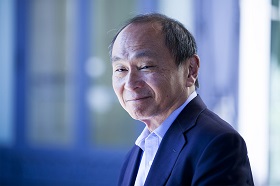
A Few Words in Defence of Francis Fukuyama
Third, hyper-globalization has produced significant economic and social costs for large numbers of people inside the liberal democracies, and this further undermines the liberal international order. Moreover, the open international economy helped fuel the rise of China, which, along with Russia’s revival, ultimately led to shifts in the global balance of powers and undermined unipolarity, which is a condition for the creation of a liberal international order.
The attempts of the United States to advance democracy through military means led to it losing a number of wars. The United States has fought seven wars since the end of the Cold War, that is, it has been at war for two out of every three years during that period. However, these wars failed to achieve their goals.
U.S. politicians have never seriously considered invading China or Russia in the years following the end of the Cold War. Nevertheless, the United States was committed to turning China and Russia into liberal democracies and integrating them into the U.S.-dominated liberal world order. U.S. leaders have not only made their intentions clear, but they have also relied on nongovernmental organizations and various sophisticated strategies to push Beijing and Moscow towards becoming liberal democracies. Their aim is essentially to bring about peaceful regime change. Predictably, China and Russia have resisted the efforts of the unipolar world for the same reason that the Americans opposes Russia’s intervention in U.S. politics.
Nationalism is the most powerful political ideology, and self-determination and sovereignty are of great importance to all countries. China and Russia resist the spread of the liberal order for realist reasons, as it would allow the United States to dominate the international system economically, militarily and politically. It is not surprising that China seeks to oust the U.S. military from the Western Pacific and that Russia has long been deeply opposed to EU and NATO expansion into Eastern Europe. According to Mearsheimer, moving these institutions closer to Russia eventually led to the Ukrainian crisis in 2014. Thus, nationalist and realist reasons forced the two major powers to challenge the efforts of the United States to create a robust liberal international order. However, we are also witnessing a push-back against the liberal international order within the liberal democracies themselves. This is due primarily to the fact that liberal countries delegate more and more authority to supranational institutions, which gives countries the impression that they are surrendering their sovereignty.
Mearsheimer references the work of Jeff Colgan and Robert Keohane here, who note that such activities “give people the sense that foreign forces are controlling their lives.” One of the reasons why the United Kingdom voted in favor of Brexit is because they thought that their country had surrendered too much authority to Brussels and had lost control over its own economy. Concerns about losing sovereignty have played an important role in the United States. Donald Trump ran for president under the slogan “America First.” In his campaign speeches, he harshly criticized all the key institutions that make up the liberal international order.
In terms of its values, liberalism is an individualistic ideology that attaches great importance to the concept of inalienable rights. This universalistic ideology is based on the idea that every individual on Earth has the same set of basic rights. This universalistic or transnational perspective stands in marked contrast to the profound particularism of nationalism, which is built on the belief that the world is divided into discrete nations, each with its own culture. Preserving that culture is best served by having one’s own state, so that the nation can survive in the face of threats from the “other.” One example of this policy is the European Union’s Schengen Agreement, which has largely eliminated borders among most of that institution’s member states. Furthermore, the European Union is deeply committed to the principle of opening its doors to refugees fleeing problems at home.
According to Mearsheimer, modern hyper-globalization, which began gaining traction in the 1980s and accelerated after the Cold War, effectively overturned the Bretton Woods consensus, which meant moderate globalization worked well for four decades. The Bretton Woods consensus promoted an open international economy while at the same time protecting national markets. For example, there were serious restrictions on capital flows across state borders and governments were afforded significant opportunities to adopt protectionist measures in the interests of sovereign states.
The new order, created largely by Western policymakers, was designed to greatly reduce regulation of global markets by removing controls on capital flows and replacing the General Agreement on Tariffs and Trade (GATT) with the World Trade Organization (WTO). In essence, Mearsheimer stresses, almost any kind of government interference in the workings of the world economy was considered harmful to the liberal international order.

Keep Calm and Carry On? A Japanese Perspective on A Post-Liberal World
Mearsheimer believes that hyper-globalization has caused a number of major economic problems that have worked to undermine the legitimacy of the liberal world order in the states that form the core of that system. An increasing number of people are left without work. The traditional economic base of numerous regions has been destroyed. The dynamism inherent in the world economy not only threatens jobs, but also fosters an acute sense of uncertainty about the future among people around the world. In addition, hyper-globalization has done little to raise the real income levels of the lower and middle classes in the liberal West.
These festering problems have led to widespread dissatisfaction with the liberal international order and growing sentiment for governments to adopt protectionist economic policies, which would undermine the present system. Trump capitalized on this hostility toward the existing order in the 2016 presidential campaign not only by railing against international institutions, but also by making the case for pursuing protectionist economic policies.
In addition, Mearsheimer notes, the ease with which capital flows across borders and the weakening of the regulatory role of national governments provokes large-scale economic crises. He is referring primarily to the Asian financial crisis of 1997–1998 and the 2007–2008 global financial crisis. Mearsheimer predicts crises in the Eurozone and the weakening of the euro as the European Union made little progress in establishing a fiscal and political union.
Mearsheimer dedicates a separate section of his paper to the engagement of China in globalization processes. Until D. Trump came to power in 2017, Western elites, in keeping with their policy of engaging, and not containing, China, were deeply committed to integrating China into the world economy, including all of its key economic institutions. They assumed that an increasingly prosperous and wealthy China would eventually become a liberal democracy and an upstanding member of the liberal international order. What the architects of that policy did not realize, however, is that by helping accelerate Chinese growth, they were actually helping undermine the liberal order, as China has rapidly grown into an economic powerhouse with significant military capability. In effect, they have helped China become a great power, thus undercutting unipolarity, which is essential for maintaining a liberal world order.
This problem has been compounded by the resurgence of Russia, which is once again a great power, although clearly a weak one economically. With the rise of China and Russia’s comeback, the international system has become multipolar, which is a death knell for the liberal international order. Neither China nor Russia has become a liberal democracy. With or without China, the liberal international order was destined to fail, because it was fatally flawed at birth. Even if the international system had remained unipolar, the liberal world order would have devolved into an agnostic order under President Trump. In actual fact, D. Trump is seemingly bent on wrecking it.
Summing up his research, Mearsheimer concludes that the various causal processes described in his paper have all played an important role in subverting the liberal international order. Although each one has a distinct logic, they have often operated synergistically. For example, the negative effects of hyper-globalization on the lower and middle classes have combined with the nationalist resentment over immigration and the sense of lost sovereignty to fuel a strong populist backlash against the principles and practices of the liberal order. Indeed, that anger has often been directed at the liberal elites who have benefited from the order and who vigorously defend it. Because the unipolar period is over, argues Mearsheimer, “there is no chance of maintaining any kind of liberal international order for the foreseeable future” [7]. Various types of realist orders will dominate the new multipolar world.
There are likely to be three different realist orders in the foreseeable future: a thin international order and two thick bounded orders — one led by China, the other by the United States. The emerging thin international order will be concerned mainly with overseeing arms control agreements, making the global economy work efficiently and climate change. The institutions that make up the international order will focus on facilitating interstate cooperation. In contrast, the two bounded orders will be concerned principally with waging security competition against each other. There will be significant economic and military competition between these two orders.
The relationship between the “thick bounded” orders led by the United States and China will resemble the bipolar world order of the Cold War period. Issues of arms control will also involve Russia. Washington, Beijing and Moscow will have to negotiate new treaties limiting their arsenals, as the superpowers did during the Cold War.
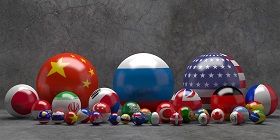
Endgame of the Long Cold War
Nevertheless, the U.S.- and Chinese-led bounded orders will be largely responsible for dealing with core security matters. The international economic situation will differ significantly from the one that existed during the Cold War. Because the world economy will remain highly interdependent, the emerging international order will play a pivotal role in managing economic relations among countries across the globe. Mearsheimer predicts that the interweaving and interaction of international economic ties between the United States and China will continue. Nevertheless, China will seek to increase its economic power. In this regard, it will attempt to rewrite the rules in the current economic institutions and will create new institutions that reflect its growing power.
As an example of China’s actions to establish economic domination, Mearsheimer points to the “Made in China 2025” plan announced by Beijing in 2015. China’s highly ambitious “One Belt, One Road” initiative, which was launched in 2013, is designed not just to help China sustain its impressive economic growth, but also to project Chinese military and political power around the globe. In this case, Mearsheimer argues, China’s strategy is to give large government subsidies to state-owned companies and supplement their research with technology stolen from American and other Western companies. China is also using its growing economic power to coerce its neighbors in East Asia to side with Beijing. The Asian Infrastructure Investment Bank, which the United States refused to join, is the main financial instrument in the creation of China’s thick bounded order.
The Trump administration’s harsh economic policies toward China are just the start of what promises to be a long-running and intense rivalry between the U.S.- and Chinese-led orders. The United States is sure to try to limit the transfer of dual-use technologies to China.
In short, the rivalry between the China- and U.S.-led bounded orders will involve both full-throated economic and military competition, as was the case with the bipolar system. The difference this time is that the international order will be deeply involved in managing the cooperative aspects of the global economy, which was not the case during the Cold War.
As for Russia, Mearsheimer notes that it is certainly a great power and an important actor in the multipolar world, although it is weak compared to China and the United States. The key question regarding Russia is: Which side, if any, will it take in the U.S.–China rivalry?
Mearsheimer does not exclude the possibility of Russia switching to the side of the United States in the future. An increasingly powerful China is the greater threat to Russia, given their geographical proximity. In this case, Russia will be loosely integrated into the U.S.-led bounded order. If Moscow chooses Beijing, then Russia’s integration into the China-led bounded order will also be insignificant. It is possible that Russia will try to avoid joining U.S. and Chinese projects and will attempt to create its own order on the basis of regional institutions under its influence.
As for Europe (the European Union), Mearsheimer assigns it a place in the U.S.-led thick bounded order. He is skeptical about the military might of the European Union in deterring China. However, he lauds its economic potential and scientific and technical infrastructure. The United States does not want Europe to sell its technologies, particularly dual-use technologies, to China. Europe is interested in the American military “umbrella” in its territory, and the United States could use this as a lever to encourage European countries to cooperate on the economic front against China.
Summing up, Mearsheimer urges, above all the ruling elites, to recognize that that the liberal international order was a failed enterprise with no future and says they should resist any temptation to continue trying to forcefully spread democracy across the planet via regime change. Further, the United States should seek to maximize its influence in economic institutions. This is important for maintaining as favorable a position as possible in the evolving global distribution of power. It is imperative that the United States not allow China to dominate these institutions. Finally, U.S. politicians should endeavor to create a formidable bounded order that can contain Chinese expansion. This means that it is necessary to continue efforts to create a Trans-Pacific Partnership and a military alliance in Asia that is similar to NATO during the Cold War. The United States should go to great lengths to pull Russia out of China’s orbit and integrate it into the U.S.-led order.
Thus, Mearsheimer concludes, the “overarching international order” that is taking shape will be based on realist principles of managing the global economy and dealing with issues of arms control and global problems such as climate change. The American political scientist believes that the world became multipolar and realist in 2016 [8].
***
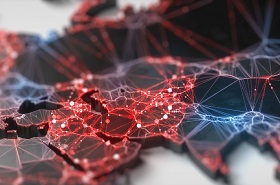
Orders Within Orders: A New Paradigm for Greater Eurasia
When Mearsheimer equates the American order of the 1990s with a liberal order, he is talking primarily about its ideology. It does not even occur to him to extend the theme of the crisis of the liberal world order to ideological liberalism and liberalism as a state form of government.
Incidentally, if we take a scientifically balanced position, then, as a modern political project, liberalism does not really exist and was never fully realized. Nowhere was the liberal program envisioned by theorists “ever completely carried out.” The liberal economist Ludwig von Mises stated as much in 1962: “Only with some exaggeration can one say that the world once lived through a liberal era” [9]. He further notes that, “In England the term ‘liberal’ is mostly used to signify a program that only in details differs from the totalitarianism of the socialists. In the United States ‘liberal’ means today a set of ideas and political postulates that in every regard are the opposite of all that liberalism meant to the preceding generations” [10].
Classical liberalism, as defined by the well-known “night-watchman state” model, did not withstand the collision with the “rebel” masses and the “leviathan state” and left the political scene without so much as a “goodbye,” giving way to the confrontation between “direct” and “representative” democracy. In both cases, they operate on similar concepts. And other the hierarchy of the “personality–society–(communitarian) state” triad makes it possible to establish significant differences between them in terms of the type of political regime.
At no point were the supporters of “direct” democracy able to bring the theoretical and alluring ideal model to its perfect incarnation. The concepts of the “communist,” “third” and “fourth” paths have inevitably butted up against human weaknesses and shortcomings, typically devolving towards authoritarian despotism or violent totalitarianism.
As for the description of “representative” democracy, there is little to add following the laconic words of Winston Churchill, who noted that “democracy is the worst form of government except for all those other forms that have been tried from time to time.”
It would be enlightening to sit in on discussions between the “liberals,” “socialists” and “conservatives” about who better observes the values of freedom, democracy, equality, human rights, patriotism and statehood. What those at the Yalta Conference (in which the leaders of the United States, the Soviet Union and the United Kingdom were equally involved) gave to the world was a system of international regimes and institutions to disseminate and maintain universal democratic values. Seven decades later, they continue to be the benchmark of morality, ethics and behavior in the international space.
The conclusion drawn by Amitav Acharya that today’s “rising powers” are not in a position to overturn the current order completely, and in fact may wish to preserve some elements of it in the near and medium term, is convincing. In this regard, Acharya defines the modern world as a “multiplex world” in which “elements of the liberal order survive, but are subsumed in a complex of multiple, crosscutting international orders.” Acharya stresses that we are talking about a multiplex, rather than a multipolar, world and believes that the world today is more complicated than it was during the American-led liberal hegemonic order. Acharya notes that this “is a world of multiple modernities, where Western liberal modernity (and its preferred pathways to economic development and governance) is only a part of what is on offer. A multiplex world is like a multiplex cinema — one that gives its audience a choice of various movies, actors, directors, and plots all under the same roof. Trump and Brexit have shown that there are serious variations and differences in the script of world order even within the West—not just between the West and the rest, as is commonly assumed. At the same time, a multiplex world is a world of interconnectedness and interdependence. It is not a singular global order, liberal or otherwise, but a complex of crosscutting, if not competing, international orders and globalisms.”
The contemporary world order is in an unstable state of transition that is fraught with global and regional conflicts. Following the disappearance of the bipolar system, which, like a hoop, connected regional spaces, and the collapse of the Soviet Union, which played the role of sheriff in its own sphere of influence, a number of countries disintegrated (Yugoslavia, Libya, Iraq and Syria) and the regions that were formed under the Versailles and Yalta systems started to undergo a period of transformation.
Joseph Nye believes that, in the absence of international government, integrated regional organizations should take responsibility for and regulate the security of peoples, their wellbeing and prosperity and environmental protection under the auspices of the great powers.
1. Keohane R. O. After Hegemony: Cooperation and Discord in the World Political Economy. Princeton University Press, 1984.
2. Nye J. S. Will the Liberal Order Survive? The History of an Idea // Foreign Affairs. Vol. 96, No. 1.
3. John J. Mearsheimer. Bound to Fail. The Rise and Fall of the Liberal International Order // International Security, Vol. 43, No. 4 (Spring 2019), pp. 7–50.
4. Ibid. p.23.
5. Ibid.
6. Ibid., p. 28.
7. Ibid., p. 40.
8. Ibid., p. 40.
9. von Mises, L. Liberalism, 2001, p. 7.
10. Ibid., p. 5, p. 7.
11. Acharya A. The end of American World Order. Cambridge: Polity Press. 2014. 224 p.
(votes: 10, rating: 4.8) |
(10 votes) |
A crisis of liberalism does not equal a crisis of the liberal world order
Russia, China and the New World OrderRussia and China enjoy a substantial advantage over the other global centres of power
Keep Calm and Carry On? A Japanese Perspective on A Post-Liberal WorldWhile Western liberals talk of the crisis of liberalism, Japanese thinkers distinguish the crisis of the liberal philosophy from the crisis of liberal elites
Orders Within Orders: A New Paradigm for Greater EurasiaAn attempt to infuse the Greater Eurasia vision with additional content will not only help Moscow to engage with other major powers more on its own terms but also ensure that Russia can maximize its impact
A Few Words in Defence of Francis FukuyamaHistory has not ended, but “the last man” has already appeared on our common horizon
Endgame of the Long Cold WarThe New Encirclement and the Existential Imperative of the Eurasian Core
Why Should We Be Grateful to Donald Trump?Donald Trump’s presidency should serve as a shock for the international community, forcing it to arise from the sweet slumber of recent decades


